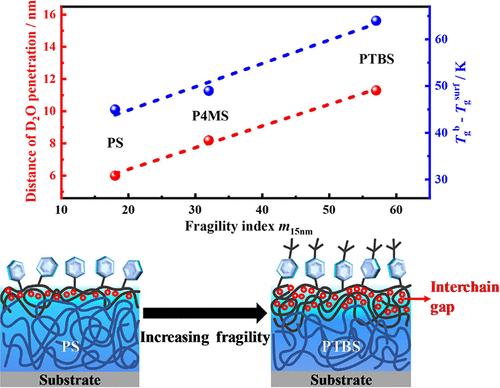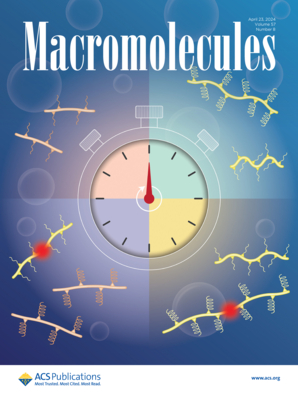具有不同大小侧基的聚合物自由表面效应的起源
IF 5.2
1区 化学
Q1 POLYMER SCIENCE
引用次数: 0
摘要
纳米约束聚合物体系中的自由表面效应非常重要。因此,了解聚合物结构对自由表面效应的影响至关重要。本文研究了苯环中含有对取代甲基和叔丁基的聚苯乙烯、聚(4-甲基苯乙烯)和聚(4-叔丁基苯乙烯)的自由表面动力学。具有大侧基团和高脆性的聚合物表现出更强的自由表面效应,这归因于表面的高自由体积以及这种不寻常的自由体积向体积传播的长距离。氧化氘蒸汽通过中子反射率渗入薄膜表面,证明了这一现象。在成膜过程中,脆性聚合物自由表面的高水平堆积失调可以得到缓解;表面的链堆积效率降低,导致自由表面的自由体积分布大而广。这项研究有助于深入了解自由表面效应与聚合物化学和物理性质之间的关系。本文章由计算机程序翻译,如有差异,请以英文原文为准。

Origin of the Free Surface Effect of Polymers with Different Sizes of Side Groups
The free surface effect in nanoconfined polymer systems is important. Hence, understanding the influence of polymer structures on the free surface effect is essential. Herein, the dynamics of the free surface of polystyrene, poly(4-methylstyrene), and poly(4-tert-butylstyrene) with p-substituted methyl and tert-butyl groups in the benzene ring were investigated. An enhanced free surface effect was exhibited by polymers with large side groups and high fragility, which was attributed to the high free volume of the surface and the long distance for this unusual free volume to propagate into the bulk. This phenomenon was proven by deuterium oxide vapor penetration into the film surface via neutron reflectivity. High levels of packing frustration could be relieved on the free surface of fragile polymers during film formation; the chain packing efficiency on the surface was reduced, resulting in a large and broad free volume distribution on the free surface. This study provides a deep understanding of the relationship between the free surface effect and the chemical and physical properties of polymers.
求助全文
通过发布文献求助,成功后即可免费获取论文全文。
去求助
来源期刊

Macromolecules
工程技术-高分子科学
CiteScore
9.30
自引率
16.40%
发文量
942
审稿时长
2 months
期刊介绍:
Macromolecules publishes original, fundamental, and impactful research on all aspects of polymer science. Topics of interest include synthesis (e.g., controlled polymerizations, polymerization catalysis, post polymerization modification, new monomer structures and polymer architectures, and polymerization mechanisms/kinetics analysis); phase behavior, thermodynamics, dynamic, and ordering/disordering phenomena (e.g., self-assembly, gelation, crystallization, solution/melt/solid-state characteristics); structure and properties (e.g., mechanical and rheological properties, surface/interfacial characteristics, electronic and transport properties); new state of the art characterization (e.g., spectroscopy, scattering, microscopy, rheology), simulation (e.g., Monte Carlo, molecular dynamics, multi-scale/coarse-grained modeling), and theoretical methods. Renewable/sustainable polymers, polymer networks, responsive polymers, electro-, magneto- and opto-active macromolecules, inorganic polymers, charge-transporting polymers (ion-containing, semiconducting, and conducting), nanostructured polymers, and polymer composites are also of interest. Typical papers published in Macromolecules showcase important and innovative concepts, experimental methods/observations, and theoretical/computational approaches that demonstrate a fundamental advance in the understanding of polymers.
 求助内容:
求助内容: 应助结果提醒方式:
应助结果提醒方式:


